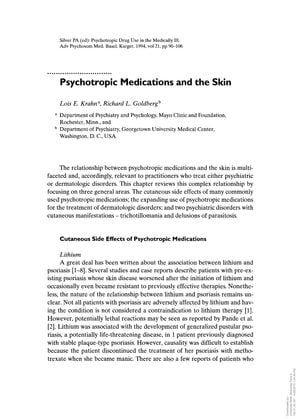Psychotropic Medications and the Skin
April 2015
in “
Advances in Psychosomatic Medicine
”
lithium psoriasis acne folliculitis alopecia chlorpromazine photosensitivity hyperpigmentation antidepressants anticonvulsants allergic reactions doxepin chronic urticaria idiopathic cold urticaria diphenhydramine herpes simplex trichotillomania clomipramine hair loss skin conditions skin disorders skin reactions skin pigmentation skin sensitivity skin allergies skin inflammation hair pulling disorder

TLDR Psychotropic medications can cause skin problems but also treat some skin conditions.
The document from 2015 examines the effects of psychotropic medications on skin conditions, detailing both adverse cutaneous side effects and therapeutic uses. It notes that lithium is associated with skin disorders such as psoriasis, acne, folliculitis, and alopecia, with varying incidences and outcomes upon discontinuation or treatment. Chlorpromazine can cause photosensitivity and hyperpigmentation, and a study with 15 patients indicated that pigmentary changes can resolve over time when switching medications. Antidepressants and anticonvulsants are linked to allergic reactions and skin conditions, some of which are reversible. Doxepin, an antidepressant, has been found effective in treating chronic urticaria and idiopathic cold urticaria, with a study of 50 patients showing its superiority over diphenhydramine. Lithium's potential antiviral effects against herpes simplex were supported by a retrospective study of 177 patients. Psychotropic medications are also used in psychiatric disorders with cutaneous manifestations, such as trichotillomania, where a 10-week study with 13 women showed clomipramine significantly improved symptoms. The document underscores the need for more research on the dermatological applications of psychotropic medications.




